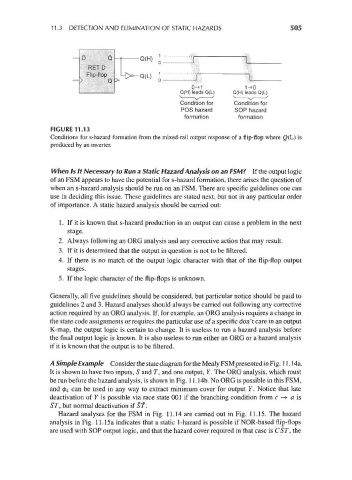Page 535 - Engineering Digital Design
P. 535
11.3 DETECTION AND ELIMINATION OF STATIC HAZARDS 505
Q(H) leads Q(L) Q(H) leads Q(L)
Condition for Condition for
POS hazard SOP hazard
formation formation
FIGURE 11.13
Conditions for s-hazard formation from the mixed-rail output response of a flip-flop where <2(L) is
produced by an inverter.
When Is It Necessary to Run a Static Hazard Analysis on an FSM ? If the output logic
of an FSM appears to have the potential for s-hazard formation, there arises the question of
when an s-hazard analysis should be run on an FSM. There are specific guidelines one can
use in deciding this issue. These guidelines are stated next, but not in any particular order
of importance. A static hazard analysis should be carried out:
1. If it is known that s-hazard production in an output can cause a problem in the next
stage.
2. Always following an ORG analysis and any corrective action that may result.
3. If it is determined that the output in question is not to be filtered.
4. If there is no match of the output logic character with that of the flip-flop output
stages.
5. If the logic character of the flip-flops is unknown.
Generally, all five guidelines should be considered, but particular notice should be paid to
guidelines 2 and 3. Hazard analyses should always be carried out following any corrective
action required by an ORG analysis. If, for example, an ORG analysis requires a change in
the state code assignments or requires the particular use of a specific don't care in an output
K-map, the output logic is certain to change. It is useless to run a hazard analysis before
the final output logic is known. It is also useless to run either an ORG or a hazard analysis
if it is known that the output is to be filtered.
A Simple Example Consider the state diagram for the Mealy FSM presented in Fig. 11.14a.
It is shown to have two inputs, S and T, and one output, Y. The ORG analysis, which must
be run before the hazard analysis, is shown in Fig. 11.14b. No ORG is possible in this FSM,
and 04 can be used in any way to extract minimum cover for output Y. Notice that late
deactivation of Y is possible via race state 001 if the branching condition from c -» a is
ST, but normal deactivation if ST.
Hazard analyses for the FSM in Fig. 11.14 are carried out in Fig. 11.15. The hazard
analysis in Fig. 11.15a indicates that a static 1-hazard is possible if NOR-based flip-flops
are used with SOP output logic, and that the hazard cover required in that case is CST, the

